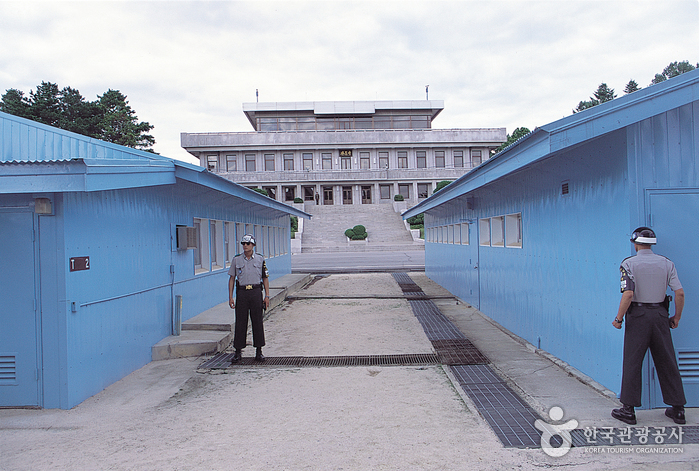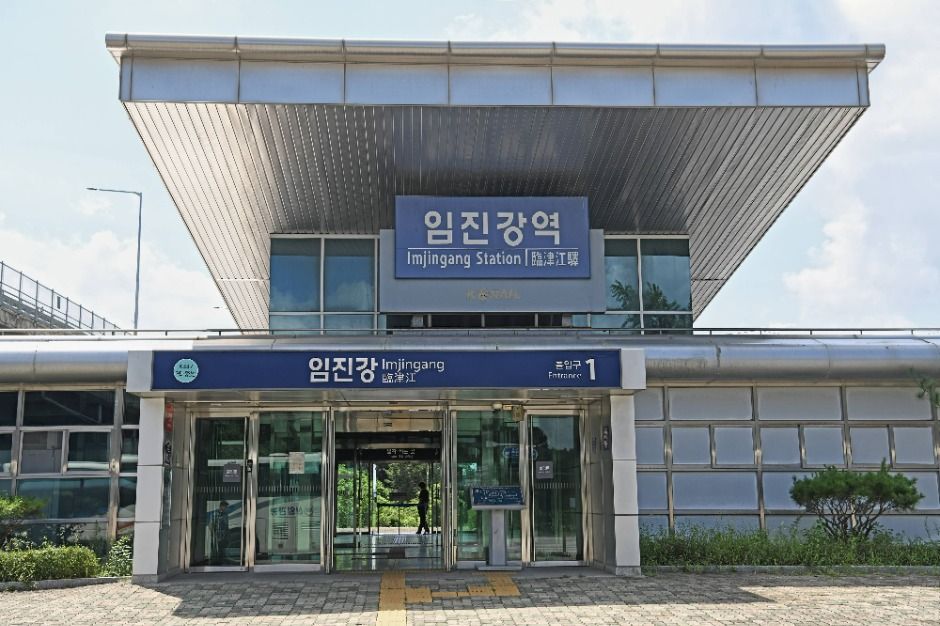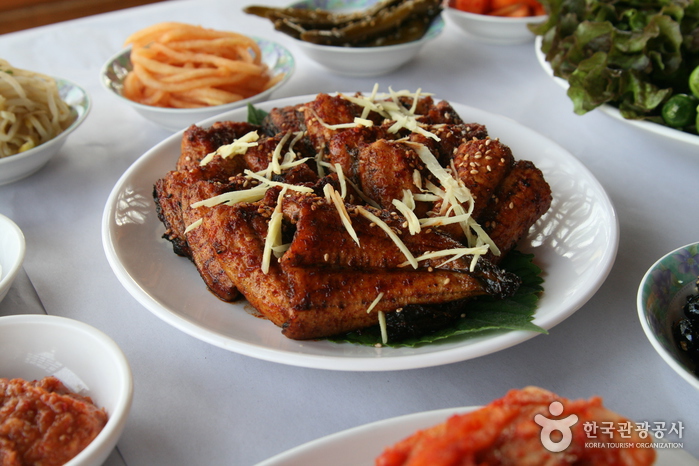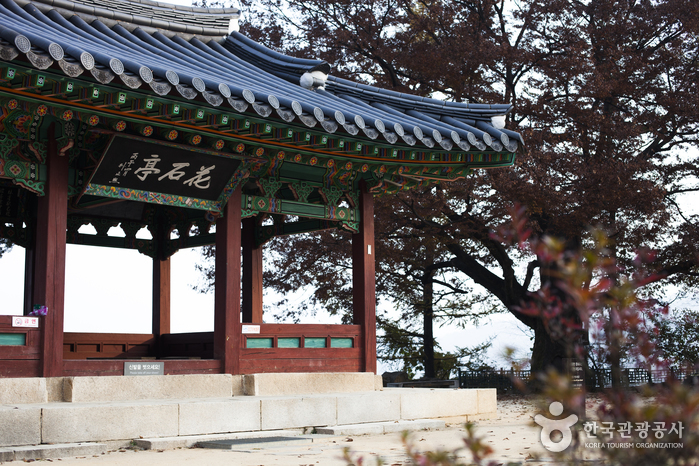The Peace Land (평화랜드)
9.7Km 2024-02-23
148-33 Imjingak-ro, Munsan-eup, Paju-si, Gyeonggi-do
The Peace Land is an amusement park located near the Imjingang River. It offers around twenty different types of rides, including a Viking ship, bumper cars, and merry-go-round. For added convenience, there is an unmanned convenience store on-site that accepts card payments exclusively, offering a variety of beverages, ice cream, and snacks. The park also has an infirmary where wound care is available. Nearby, visitors can enjoy the Peace Gondola, which provides a scenic way to cross the Imjingang River.
Panmunjeom (Joint Security Area) (판문점)
9.7Km 2024-02-29
148-40 Imjingak-ro, Paju-si, Gyeonggi-do
+82-1588-8889
Panmunjeom is the site of the Armistice Agreement that signaled the ceasefire of the Korean War (1950-1953) and is located in the Demilitarized Zone (DMZ), just 50 kilometers north of Seoul. It remains a venue for talks between South Korea and North Korea, allowing visitors to observe North Korean troops up close. Since it is a civilian-controlled area, individual tours are not permitted; they must be arranged in advance through a tour operator designated by the United Nations Command. Visitors must bring valid identification, such as a passport or alien registration card.
Imjingang Station (임진강역)
10.1Km 2025-09-04
115, Imjingak-ro, Munsan-eup, Paju-si, Gyeonggi-do
+82-31-954-1074
Imjingang Station was the first station to connect the North-South Railway and started operating on September 30, 2001 near Imjingak Resort. A sightseeing train, DMZ-Train, is operated from the station as well.
Bangujeong Naruteojip (반구정나루터집)
12.1Km 2024-02-27
13, Bangujeong-ro 85beon-gil, Munsan-eup, Paju-si, Gyeonggi-do
031-952-3472
This restaurant, set in an elegant hanok, is a historic establishment specializing in Minmuljangeogui (Grilled freshwater eel). Eels, a popular health food in Korea, are typically prepared salt-grilled or marinated in a sweet soy sauce-based mixture before grilling. When the eels are plump, they are charcoal-grilled to achieve a characteristic crispy exterior and tender interior. The grilled eel pairs excellently with the assortment of side dishes, including a clear Kongnamulguk (Bean sprout soup). Complete your meal with a Megimaeuntang (Spicy catfish stew) featuring Sujebi (Hand-pulled dough).
Bangujeong Pavilion and Historic Site of Hwang Hui (반구정과 황희선생유적지)
12.2Km 2024-02-07
3 Bangujeong-ro 85beon-gil, Munsan-eup, Paju-si, Gyeonggi-do
Bangujeong is a pavilion situated in the lower reaches of the Imjingang River. It's where Hwang Hui (1363-1452), a civil servant from the late Goryeo and early Joseon dynasties, spent his later years after resigning from his position as Yeonguijeong, the highest-ranking official in the Joseon dynasty. This historic site dedicated to Hwang Hui includes a shrine erected in his memory and the Gyeongmojae Shrine, which houses details about his accomplishments.
Homeplus - Paju Munsan Branch [Tax Refund Shop] (홈플러스 파주문산)
14.0Km 2024-04-18
1759, Bangchon-ro, Munsan-eup, Paju-si, Gyeonggi-do
-
Hwaseokjeong Pavilion (화석정)
14.2Km 2021-12-14
152-72, Hwaseokjeong-ro, Paju-si, Gyeonggi-do
+82-31-940-5831
Hwaseokjeong Pavilion was built in honor of Gil Jae, a Goryeo dynasty Confucian scholar who had resigned from his government post to train young scholars. Overlooking the Imjingang River, the pavilion provides a good resting area dotted with zelkova trees.
Olive Young - Paju Dangdong Branch [Tax Refund Shop] (올리브영 파주당동)
14.2Km 2024-04-17
1725, Bangchon-ro, Munsan-eup, Paju-si, Gyeonggi-do
-
Olive Young - Paju Munsan Branch [Tax Refund Shop] (올리브영 파주문산점)
14.9Km 2024-06-27
#104, 71, Munhyang-ro, Munsan-eup, Paju-si, Gyeonggi-do
-
Yulgok Arboretum (율곡수목원)
14.9Km 2023-02-02
392, Jangseungbaegi-ro, Papyeong-myeon, Paju-si, Gyeonggi-do
Yulgok Arboretum was established for the preservation, proliferation, and exhibition of plant genetic resources, and provides a variety of resort services related to forest culture for citizens. It features a four seasons garden, conifers garden, rock garden, fruit tree garden, Saimdang Forest, and many other beautiful venues, and also offers diverse forest experiences. It also provides a forest experience program for infants and toddlers as well as a forest healing program in which people of all ages and genders may participate. The Dulle Trail surrounding the arboretum runs some 5 kilometers in length and exudes diverse views from its observatory, pine scent path, and Munbawi Rock. From the arboretum, you will be able to see the Imjingang River to the north and great mountains such as Papyeongsan and Gamaksan to the east. It is possible to tour the historical sites of Yulgok Yi I and Hwang Hui as well since they are close by.




![Homeplus - Paju Munsan Branch [Tax Refund Shop] (홈플러스 파주문산)](http://tong.visitkorea.or.kr/cms/resource/45/2880745_image2_1.jpg)

![Olive Young - Paju Dangdong Branch [Tax Refund Shop] (올리브영 파주당동)](http://tong.visitkorea.or.kr/cms/resource/08/2888108_image2_1.jpg)
 English
English
 한국어
한국어 日本語
日本語 中文(简体)
中文(简体) Deutsch
Deutsch Français
Français Español
Español Русский
Русский